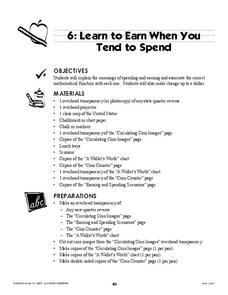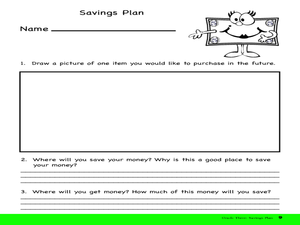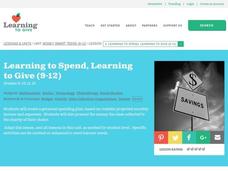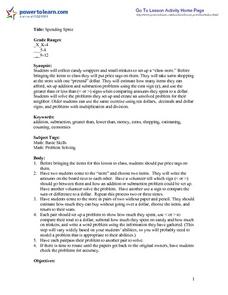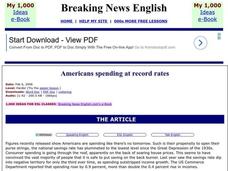Curated OER
Learn to Earn When you Tend to Spend
Analyzing and understanding word problems is extremely important. Pupils learn that in money problems, earn usually means you add and spend usually means you subtract. They will solve a series of money-related word problems, label coins,...
Curated OER
Consumer Borrowing and Spending
Credit can be confusing for teens, some of whom are already using credit cards. Clear up misconceptions with this group research activity which has a solid outline with a lot of room to adjust to your needs and resources. Groups are...
Curated OER
What Can You Do With Money?
Learners watch a Biz Kidz video about money, learn what they can do with money, and fill out worksheets on what they learn. Students learn about spending, saving, donating, and investing.
Curated OER
Children's Literature Across the Curriculum Ideas-If You Made A Million
Students read If You Made A Million by David M. Schwartz. They complete a variety of cross-curricular activities surrounding the study of earning, saving and spending money. Included are reading, art, math, science, writing, social...
Curated OER
Money, Money, Honey Bunny!
Students read a story about spending and saving money and talk about the difference between goods and services. For this money lesson plan, students also play a matching game to review the story and practice rhyming words from the story.
Curated OER
Meet Molly An American Girl
Students examine concepts of personal finance. In this personal finance lesson, students use Valerie Tripp's, Meet Molly, An American Girl, to learn about saving and spending after World War II. They compare financial decisions after...
Curated OER
Having a Savings Plan
Students discover the importance of saving and spending. In this finance instructional activity, students read the book Kermit the Hermit and discuss the differences between needs and wants. The students complete worksheets concerning...
Curated OER
Thinking About Money
Students evaluate various approaches to spending money.In this spending money literacy lesson, students broaden their financial goals by reading "Alexander Who Used to Be Rich Last Sunday" and "A Chair for My Mother."Students use a Venn...
Curated OER
Tarantula Shoes
Students read a book about Ryan O'Keefe, a young man who wants a pair of basketball shoes promoted by a basketball star. They explore about spending, saving, opportunity cost, and trade-offs as they study Ryan's decisions throughout the...
Council for Economic Education
Government Spending: Why Do We Spend the Way We Do?
Learners examine the categories for federal spending using the internet to locate them. They create a list of expenditures noting them as government purchases or transfer payments. They analyze the patterns of spending during the past 40...
Curated OER
A Family Spending Plan
Students investigate family expenditures. In this family budget lesson, students examine the wages and expenditures of family and then create a monthly budget for the family to follow.
Curated OER
Money, Money, Honey Bunny!
Students determine the differences between goods and services, and saving and spending. In this economics lesson, students listen to a rhyming story about a bunny with money. They play a matching game with the associated cards and work...
Curated OER
Learning to Spend, Learning to Give
Students explore the concept of personal finances. In this personal finances lesson, students identify their income and expenses. Students create a budget for their spending, saving, investing, and donating habits. Students draw graphs...
Curated OER
How You Use Credit Cards Should Determine How You Choose Them
Young scholars explore the concept of credit cards. In this credit cards lesson, students read an article about credit card spending. Young scholars discuss different ways in which people use credit cards. Students determine what kind of...
Curated OER
Spending
Students participate in a lesson that illustrates the concept of spending and how it effects the economy. Technology is integrated in this study with the use of a computer simulation of a pinball game that shows how fast money can be spent.
Curated OER
Spending Spree
Young scholars collect objects to use in a classroom store. In groups, they must place a value on each object and take turns spending their fake dollar in the store. They predict how much they can buy and use addition and subtraction...
Curated OER
Saving and Spending
Students identify the reasons why they believe people save money. After this list, they discuss what they spend their money on and determine if the reasons for saving money change over time. In groups, they use the story of "Uncle Jed's...
Curated OER
Needs and Wants
Students examine the difference between psychological needs and wants to control spending.
Curated OER
The Berenstain Bears' Mad, Mad, Mad Toy Craze
Young scholars use the book, The Berenstain Bears' Mad, Mad, Mad Toy Craze, to explore spending, collecting, opportunity cost, saving, and speculating.
Curated OER
Americans Spending at Record Rates
For this Americans spending at record rates worksheet, 8th graders read or listen to an article, discuss money topics, answer 8 true or false, match 10 synonyms, and 10 phrases, fill in 16 blanks, answer 6 short answer questions,...
Curated OER
Where Does All the Money Go?
Students explore the concept of uses for money. In this uses for money lesson, students discuss ways in which money can be utilized such as spending, saving, investing, donating, etc. Students discuss the differences between needs and...
Curated OER
Month 2 Budget
In this consumer mathematics worksheet, students complete a monthly budget by completing each category on the sheet. They fill in the blanks and calculate their totals for month two.
Curated OER
Month 3 Budget
In this consumer mathematics worksheet, students complete a monthly budget form by filling each of the categories. They fill in their total expenses for each category and calculate their budget for month three.
Curated OER
Month 5 Budget
In this consumer mathematics instructional activity, students complete the following statements with their appropriate information. Then they calculate their total expenses and subtract a portion for savings.


